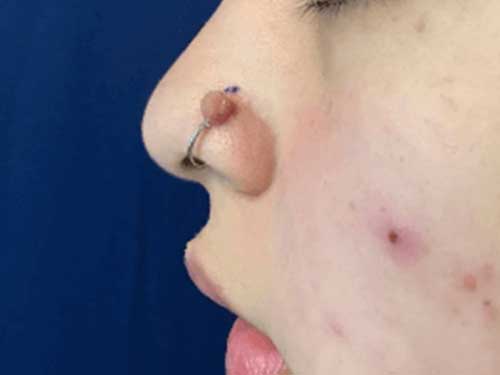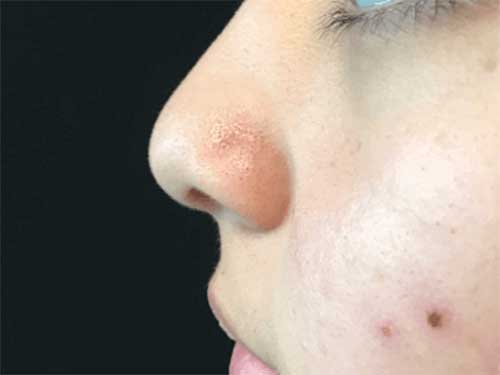Pyogenic Granuloma Overview
Pyogenic granuloma is a relatively common, benign skin growth. It usually presents itself as a small, raw bump that is bloody-red in color.
It often seems to follow a minor injury and grows rapidly over a period of a few weeks to an average size of half an inch. These skin growths mainly affect children and young adults, although they can develop in people of all ages. They are also relatively common in pregnant women. The hormone changes that occur during pregnancy can cause these growths to develop. Dr. Mountcastle will present all the treatment options which are dependant on the size, location, and age of the patient.
Pyogenic Granuloma Before and After*
See More ResultsSurgical Technique
Although pyogenic granulomas are benign, we recommended that a sample is obtained for biopsy analysis, for a more accurate diagnosis. A biopsy also helps rule out malignant, or cancerous, medical conditions that can cause a similar kind of growth, such as squamous cell carcinoma, basal cell carcinoma, and melanoma. A true pyogenic granuloma may be challenging to treat since as many as half of treated cases will recur (grow back) and need a second treatment. Most pyogenic granulomas are treated with an instrument called a curette and lightly cauterized to decrease the chance they will re-grow. An injection of local anesthesia is required. Laser surgery can also be done but has not been proven to be superior. The highest cure rates are obtained when the growth is removed by full thickness surgical excision and closed with stitches.
During/After Surgery
Pyogenic granulomas can grow rapidly and often bleed very easily. These lesions tend to persist and get more prominent; consequently, it is recommended to remove pyogenic granulomas. Our surgical approach usually involves removing the pyogenic granuloma under local anesthesia, followed by curettage and cauterization of the base of the lesion. This procedure often results in an acceptable scar that continues to improve over time. In some cases, surgical excision with the placement of sutures may be necessary. Patients should seek follow-up care as early as possible if any evidence of recurrence of the pyogenic granuloma is present.
Pyogenic Granuloma Faqs
Where do Pyogenic Granulomas Occur?
They are commonly found on the:
- Hands
- Fingers
- Arms
- Face
- Neck
- Chest
- Back
They can also grow on the:
- Lips
- Eyelids
- Genitals
- Inside the mouth
What causes a Pyogenic Granuloma?
It’s not always clear what causes a pyogenic granuloma. These growths can occur after injuries, but the reason for this isn’t known. Other causes of pyogenic granulomas include trauma caused by bug bites or by scratching your skin roughly or frequently. The hormone changes your body goes through when you’re pregnant can also cause pyogenic granulomas. Certain medications can also cause this condition. These include:
- Indinavir (Crixivan)
- Isotretinoin (Accutane)
- Acitretin (Soriatane)
- Some birth control pills
Financing Available
Financing InfoRequest An Appointment
Contact Us
